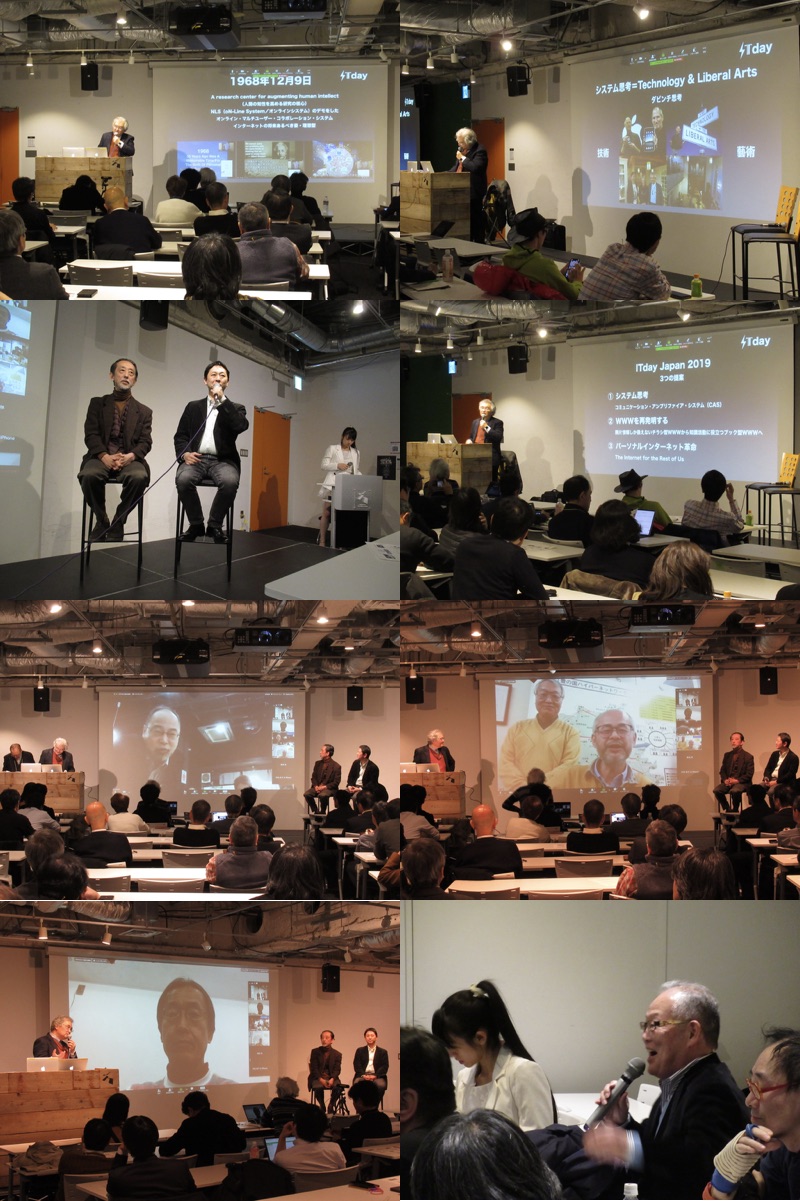51st Anniversary of The Demo by “The Father of IT Revolution”, Douglas Engelbart
ITday Japan 2019
“To be IT surveillance society, or to be IT civil society, that is the question”
December 9, 2019
On December 9 (Monday), the 51st anniversary of Douglas Engelbart The Demo “ITday Japan 2019 ~ To be IT surveillance society, or to be IT civil society, that is the question ~” was held at the Ochanomizu Digital Hollywood University in Tokyo.

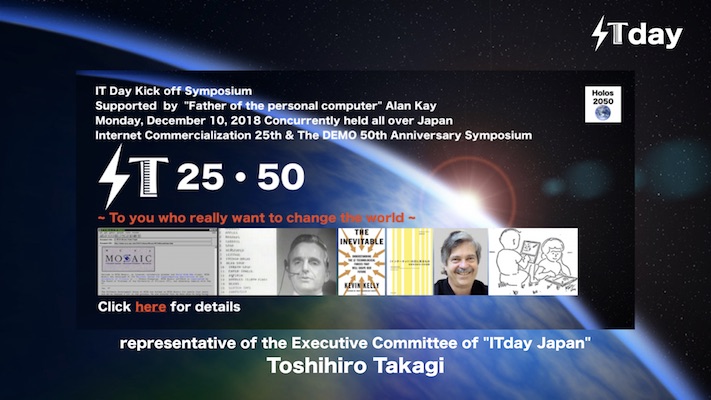
Think Different
First, Toshihiro Takagi, representative of “ITday Japan” symposium executive committee, gave a keynote speech.
At the beginning, Takagi introduced a picture of Steve Jobs in front of the message “Think Different”. The word “Think Different” was a magical word. In 1997, Jobs returned to Apple on the verge of bankruptcy and transformed Apple into the world’s largest company by market capitalization in 14 years to 2011. And he died.
Now the world situation is suspicious, and there are frequent protests against the current political and economic system, such as Hong Kong demonstrations and Greta Thunberg’s environmental demonstrations. In other words, the whole world is stuck and is on the verge of bankruptcy. Today I will talk about how to “Think Different” to get out of this situation.
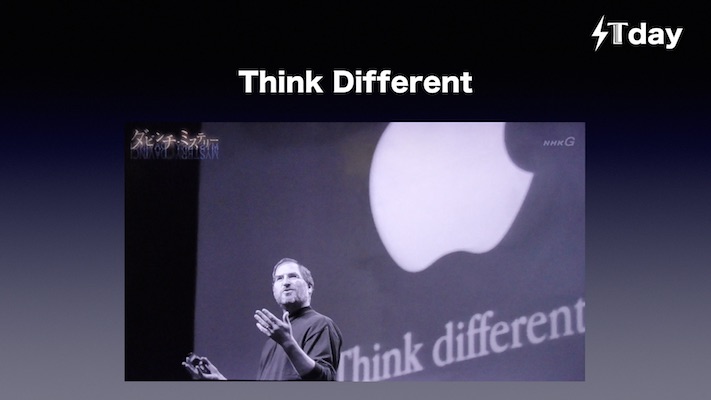
Then, introduced NHK specials “The Disappeared Lawyers: The Reality of China’s“ Law ”Society” and “The Tiananmen Incident: The Fifty Days That Decided Destiny”. The inhuman nature of the Chinese “law” society which suddenly abducted lawyers who protect human rights and made them robotic, and The current Chinese administration that slaughtered many people in the Tiananmen incident never accepts the claims of Hong Kong citizens. That is the reality we are facing.
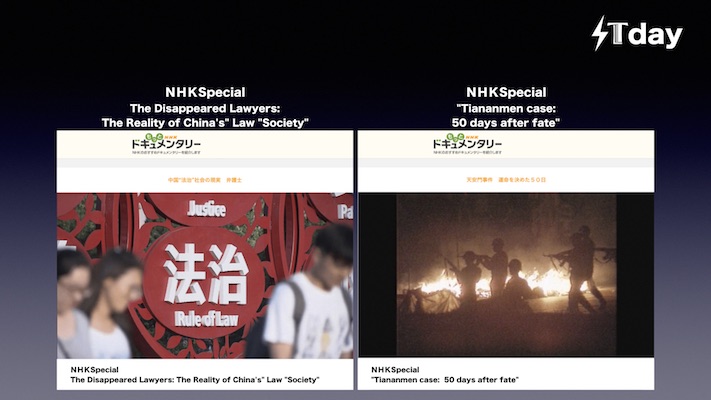
What is “ITday”?
And he went into the main subject. First, he talked about what “ITday” is and why we are doing “ITday” activities.
“ITday” is the IT anniversary. On December 9, 1968, Douglas Engelbart’s “The Mother of All Demos / The Demo / The Big Demo” was held, which became the starting point of “IT Revolution”. Therefore, we set December 9 as “ITday”. Every year, we hold “ITday Symposium” all over the world, and discuss the theme of “How can we develop IT that augment human intellect” suggested by Engelbart. “ITday” is an activity to create an ideal future society “IT civil society” with such excellent IT.
The most famous of The Demo was the first time that a “mouse” was used to operate a computer. This became the starting point for the Personal Computer Revolution, opening up the computers that had previously been monopolized by experts to the general public.
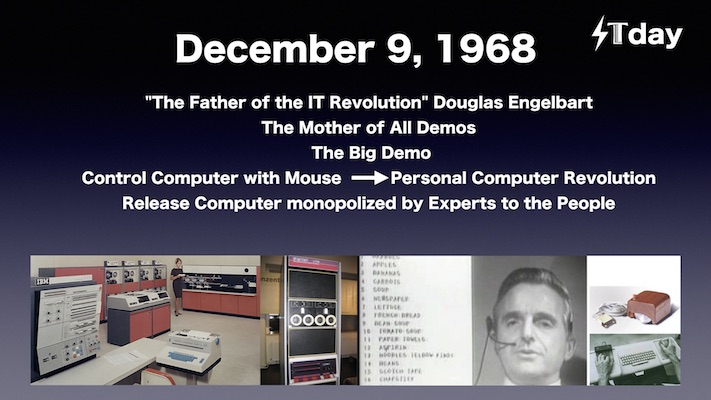
Actually, there is another important point. That is because Engelbart posted the theme “A research center for augmenting human intellect”. And he demonstrated an online multi-user collaboration system called NLS (oN-Line System). The Demo was held a year before the Internet started in 1969, and he already showed the ideal future Internet at that time. How about the current Internet compared to that? Has it reached a level that augment human intellect ? Not at all. On the contrary, fake and hate are prevalent, and rather than augmenting intellect, it seems to reducing it. Nor can multi-users work online to solve the complex and serious problems facing humanity. In short, The Demo is by no means an old tale, but pointing to the future we should aim for. Therefore, the mission of “ITday” is to propose that the general public will realize the ideal IT society of the future that Engelbart advocated in The Demo, and to expand the circle of its activities worldwide.
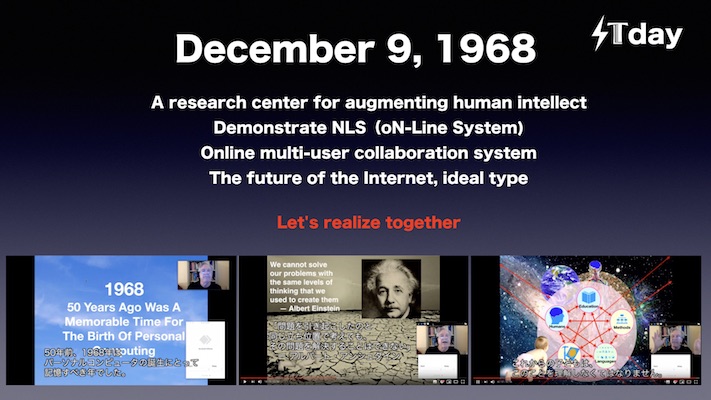
①System Thinking
So how can we specifically improve human intelligence and solve complex and serious problems facing humanity?
I would like to start with a story that the answer is “System Thinking”.
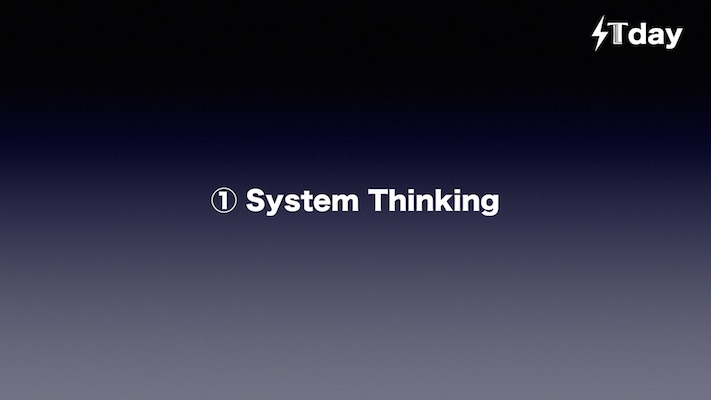
What is “System Thinking”? There was a program that taught the answer in an easy-to-understand way. NHK Special “Da Vinci Mystery Vol. 2 Mystery of Universal Genius ~Reality Revealed by the Latest AI ~ ”. Why could Leonardo Davinci become a “universal genius”? It is by “System Thinking”. The key to understanding and solving complex phenomena such as natural world and human society is “System Thinking”, which is the key issue in the future AI era. That is, “The thinking method, seeing everything in relation, connection, and context, regardless of existing common sense.
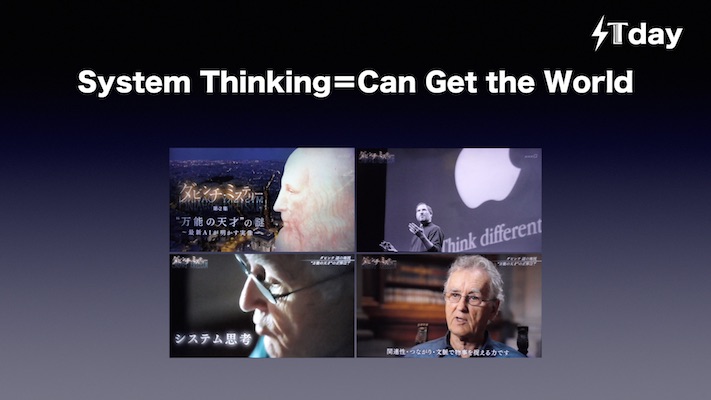
“System thinking” is a way of thinking that can understand the essence of the world. It is also a way of thinking that can change the world.
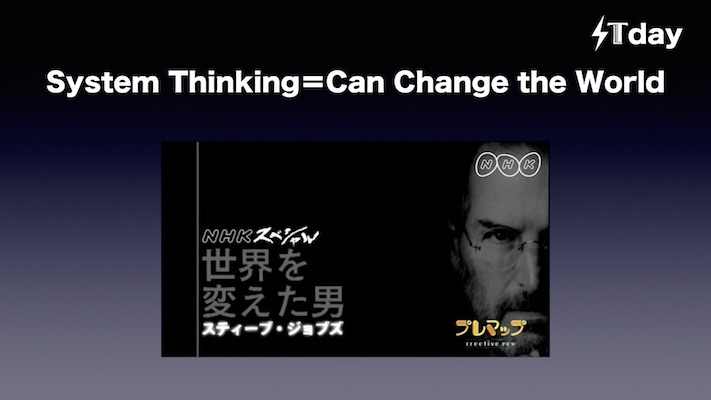
Leonardo DaVinci, Douglas Engelbart, Alan Kay, Steve Jobs, all seem to have learned “System Thinking” that can gained the essence of the world and change the world.
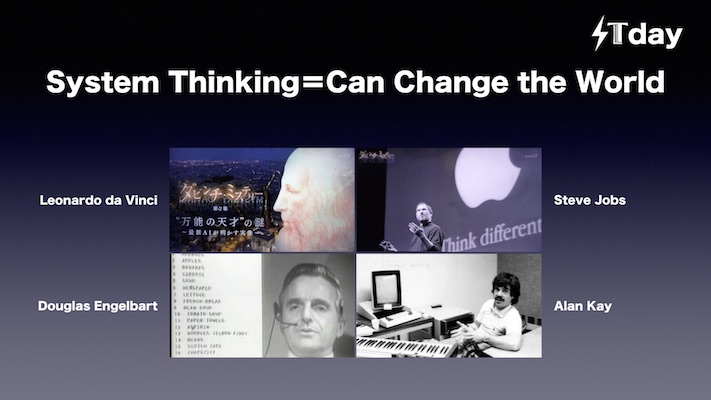
Last year, on December 10, 2018 (Japan time), we held “IT25 · 50” symposium, which was the 25th anniversary of the Internet commercialization / The 50th anniversary of Douglas Engelbart The Demo. In the keynote, Alan Kay said, “Engelbart was doing” System Thinking. ”
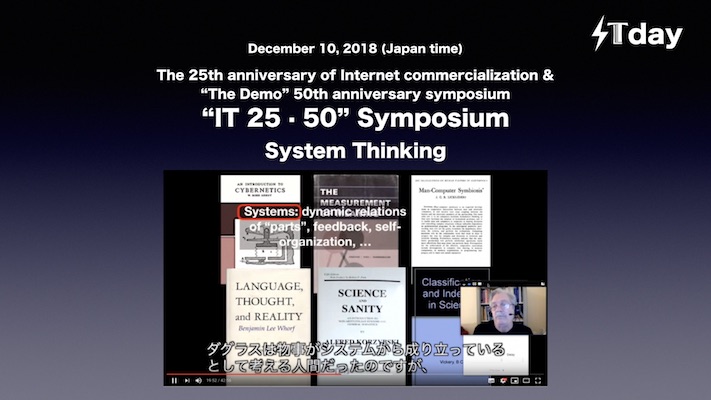
And he said “By combining Humans, Education, Methods, Languages, and Tools and functioning as systems, we should increase human intelligence and work together to solve serious problems facing humanity.” Thus, it is extremely important to understand Engelbart’s “System Thinking”, but even now, 51 years after The Demo, we have not yet realized it.
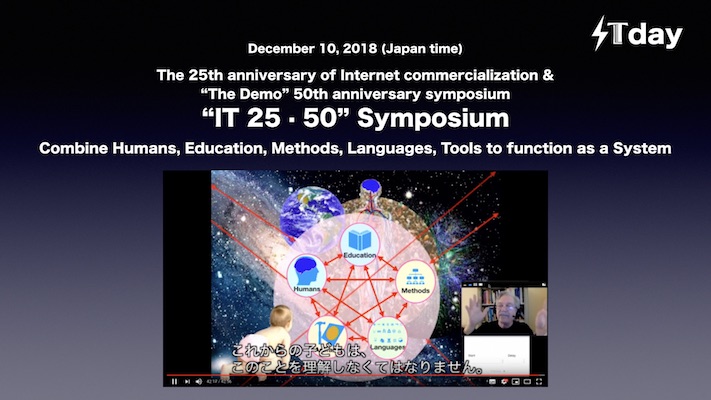
DaVinci left 5,600 pages of manuscripts. As a result of scanning all of them and conducting AI analysis, various things became clear. For example, DaVinci left his manuscript about the relationship between the sun, the moon, and the earth 100 years before Galileo published the theory of ground motion.
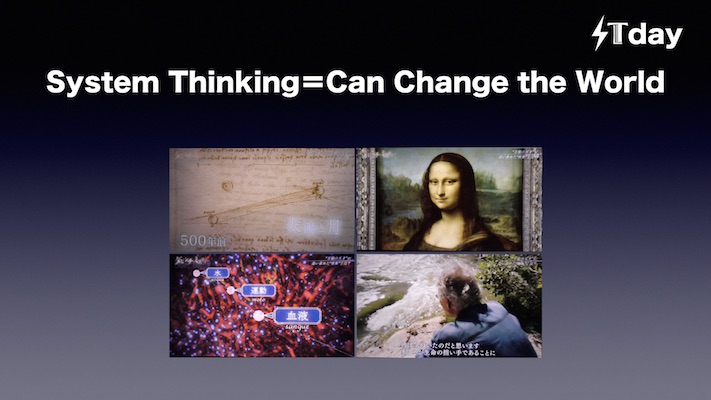
He also left an accurate map. As a result of AI analysis, an instrument was found that he probably measured with this.
When we actually made the instrument and measured it, we found that it fit perfectly with the satellite image.
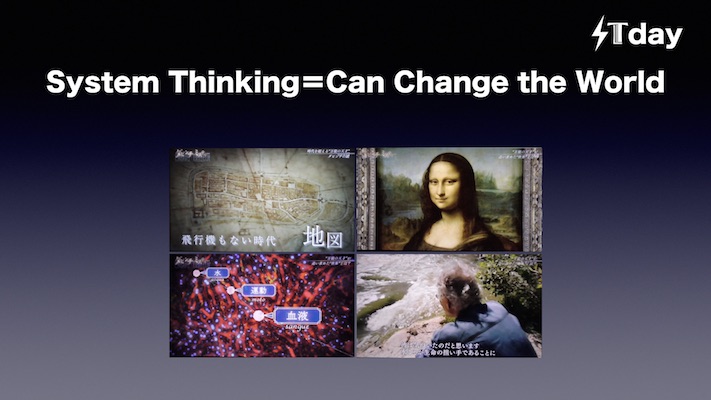
“The valve inside the artery closes because of the eddy of blood flow.” This discovery was probably because DaVinci was interested in water from an early age and realized that water was the bearer of life. The program speculates that he portrayed nature, including rivers, in the background of several portraits, including “Mona Lisa.”
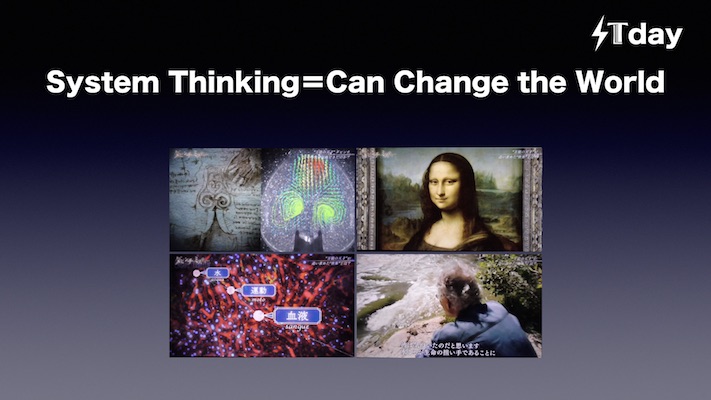
The background of “The Virgin and Child with Saint Anne” also depicts a landscape with such a river.
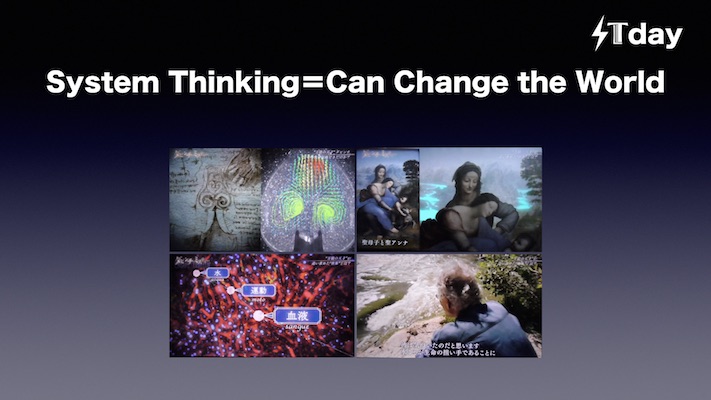
So how do you get “System Thinking”? The hint comes from the term Jobs repeted twice in his later life, “The intersection of technology and liberal arts.” This is the term that Jobs stated at the end of the keynote speech when the first iPad was announced in January 2010, and when the iPhone 4 was announced in June 2010. He said “The reason that Apple is able to create products like the iPad is because we’ve always tried to be at the intersection of technology and liberal arts.” It reveals the secret of why Apple was able to create a great product and thereby become the world’s largest company in terms of market capitalization. However, many did not try to understand its true meaning, and it was not an easily understandable word. I’ll reveal its true meaning to you here today. Of course, that’s the real meaning I understand. First of all, “liberal arts” comes out as “Kyoiku (Education)” when you look it up in a dictionary. However, at the intersection of Technology and Education, You cannot understand at all what he said.
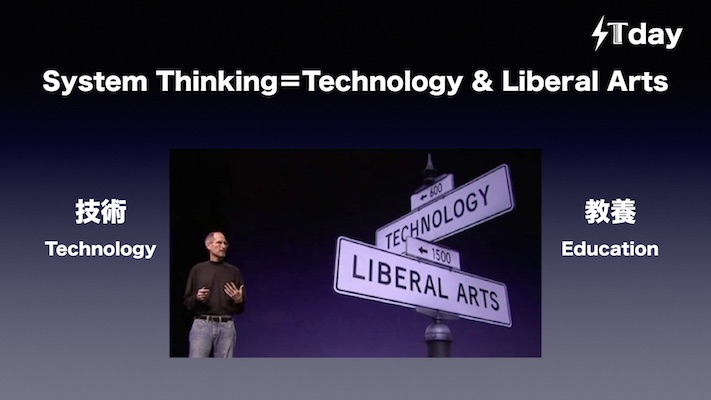
It is correct to translate “Geijutsu” as “Liberal arts”. This is because the word “Geijutsu”” was coined by Nishi Amane as a translation of “Liberal arts” in the Meiji era. Today, the term “Geijutsu” is considered a translation of “Art,” whereas the term “Art” is used in rather superficial, less-deep works. “Liberal arts” is a deeper word used to mean “to pursue all disciplines, without any premise, to a thorough artistic level.” Originally, “Education” is a word that means “learning the studies to the limit and to the artistic level,” but the word “Education” that we usually use do not have such a deep meaning. Therefore, this should be translated as “Geijutsu”. Also, many people think that the term “Technology” also means “computer technology” or “engineering” because Jobs uses it, but that is also wrong. The word “technology” includes not only such science and technology, but also “bureaucracy”, “law”, “state”, “military”, “money”, “economy”, “management”, “work”, and “school. It includes all kinds of techniques, what we call the “institution”. And Japanese bureaucrats, politicians and experts are just talking about this technique. Or, both “technology” and “arts” are missing. That is why Japan is useless.
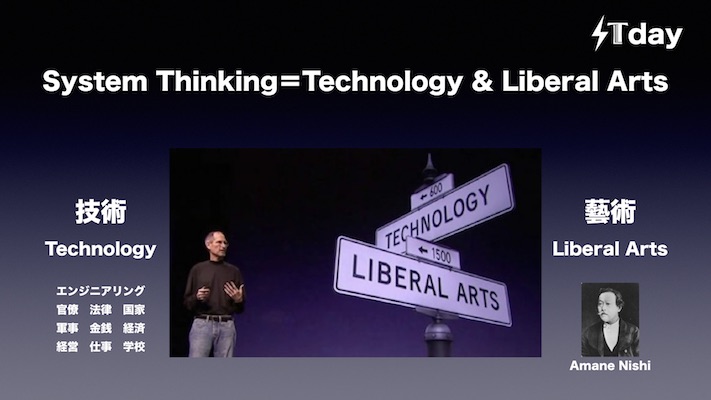
“Intersection of Technology and Liberal arts” means “intersection of Gijyutu and Geijyutsu”, which can be clearly understood by replacing it with DaVinci. “System Thinking” can only be learned when it is located at the “intersection of Technology and Liberal arts”. In short, it is easier to understand if you think of it as “DaVinci Thinking”.
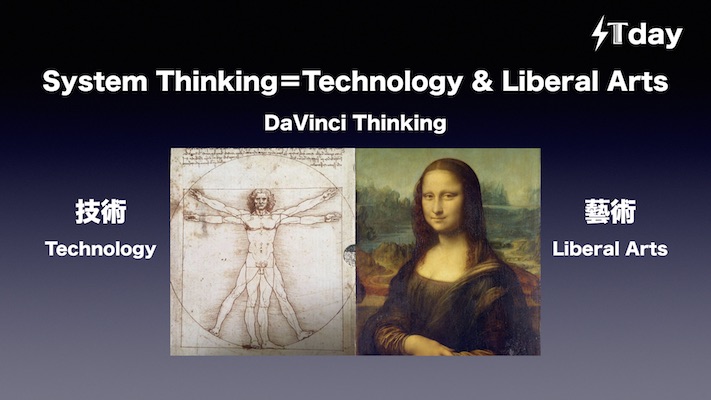
By locating at the “intersection of technology and liberal arts”, Jobs has launched an innovative product, the iPhone and iPad, which has made Apple world number one company with a market capitalization. The picture on the left below shows me and one of the panelists, Sonoda-san, visiting Alan Kay’s home. Behind them is a pipe organ. Are there any of you who have a pipe organ at home today? The photo on the right shows a classical concert in a large room with the pipe organ. When I asked Alan Kay, “I would like to visit your home for meeting about keynote.” he said I’m going to do a concert at that time, so why not come along with it? “And he invited us. Alan Kay was a professional musician when he was young. During the day, he works as a computer scientist, and at night he plays jazz as a professional guitarist. Only those who excel in both “Technology and Liberal arts” could do “System Thinking” and change the world.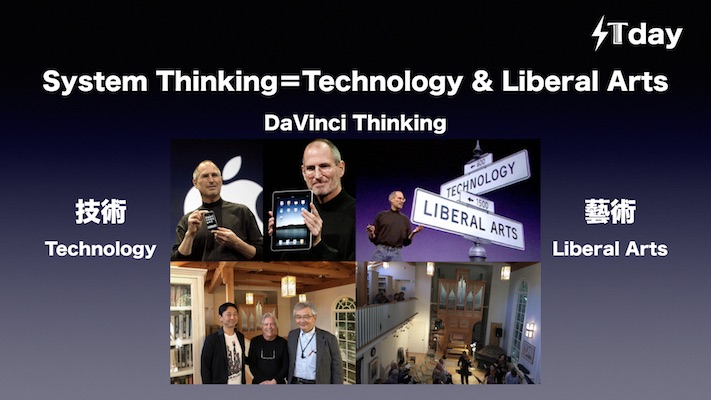
And, in fact, the idea of “the intersection of Technology and Liberal arts” is very close to traditional Japanese culture. In 2011, when Jobs died, I wrote the book “The History of Jobs & Apple” and “The Legend of Jobs”. Then, I convinced that half of the secrets of attractive Apple products are in Japanese culture.
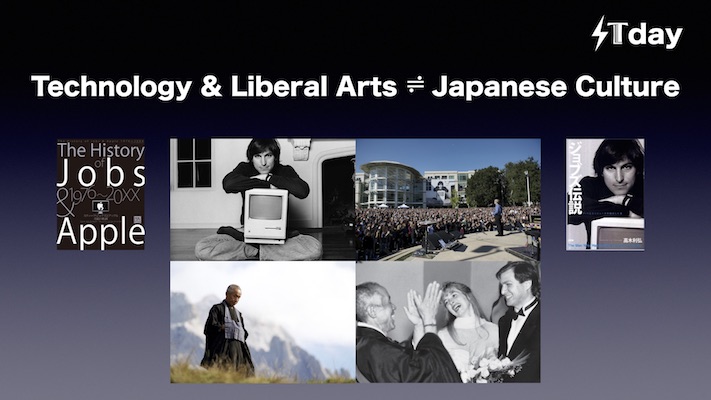
The upper left photo is when Jobs announced the first Macintosh in 1984. He sit in Zen meditation and has his Macintosh on his crossed legs. The photo on the upper right shows the memorial ceremony held at Apple Campus when Jobs died in 2011. This photo was displayed on the wall of the building at that time. It is a picture that symbolizes the life of Jobs that much, but the message in it was “I invented the Macintosh with this (Zen spirit)”. Jobs was adopted as soon as he was born. It sounds good to be adopted, but it also meant that they were not loved by his parents and was abandoned. He worried about that from an early age and wandered around India, but only met Zen priest Kobun Chino to gain mental stability for the first time. “Abandon everything and face yourself.” This Zen spirit led to “System Thinking”. Jobs also respected Japanese craftsmanship. And the aesthetic sense of the Japanese. Jobs found the essence of “System Thinking” in traditional Japanese culture, thereby developing great products and leading Apple to the world’s market capitalization. On the other hand, what about Japanese people? In the process of modernization, we have destroyed ourselves without respecting this wonderful Japanese traditional culture. What happened as a result? Now, we can no longer produce great products and services, and we have lost sight of where to go.
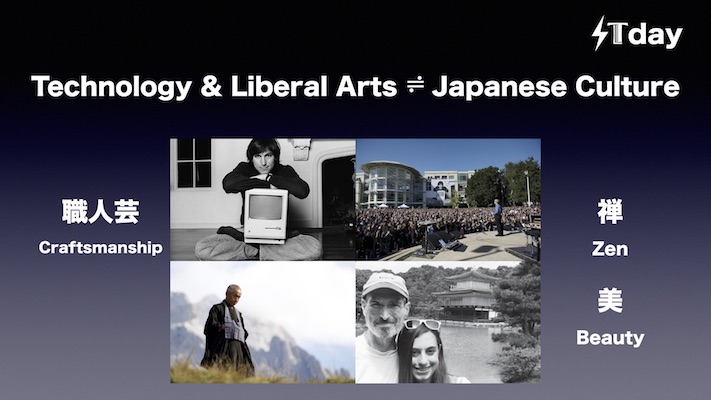
The theory of “Communication Amplifier System (CAS)”
So how do we specifically understand human society through “System Thinking”? Here, as an example, I introduce the theory of “Communication Amplifier System (CAS)” inspired by Alan Kay. In 2014, Japan’s leading media scholar, Prof. Yasuki Hamano, died. At that time, I decided to re-read all his major works. At that time, I discovered the following words of Alan Kay in the masterpiece “Hypermedia Galaxy” and thought, “This is it.” “Computers are communication amplifiers. I think planes are communication tools and copiers are communication tools. People at railway companies think they are in the railway industry. IBM people think they are in the computer industry, but both are actually in the communications industry.”

First, the words “computers are communication amplifiers” are the perfect words for expressing the excitement of my first touch with the Macintosh. When I touched my Mac, I could talk to this machine. The conversation bounced. pleasant. Mysterious feelings such as excitement came out. And even if you were talking about Macs between users, the conversation would still bounce. pleasant. I did’t think there was any better word to express this feeling of empathy and excitement. Macintosh is a product developed and inspired by Alan Kay’s “Dynabook Concept”. This is exactly what Alan Kay’s idea of “a computer that amplifies communication” is inherited. And I thought that the term “communication amplifier” was a perfect word to describe the appeal of not only computers but all products and services.
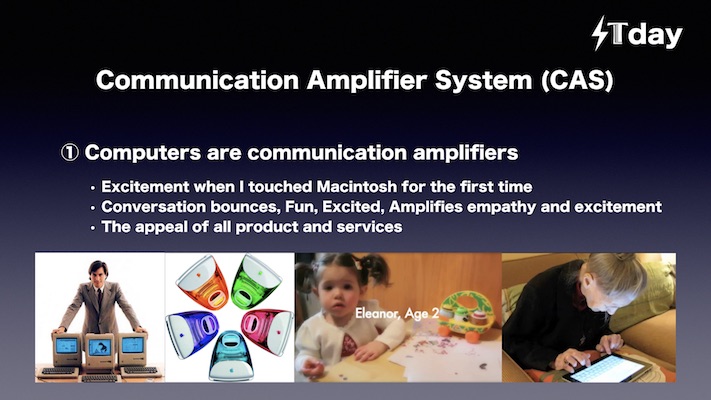
Second, Alan kay’s flase, “Airplanes, copiers, railways, and IBM computers are all tools for communication and the communication industry.” Hamano said, “The word communication means transportation. “Kay is just saying something natural,” but I thought this could be extended to “every human activity is a communication activity.” “Communication” in the dictionary includes “Exchange of information and emotions (Messages flow)”, “People traffic (People flow)”, “Goods traffic and Logistics (Goods flow)”. If you add “Buying and Selling (Money flow)” to “Communication”, I think that human society could be defined as “a Communication Amplifier System composed of matrices of Messages flow, People flow, Goods flow, and Money flow.” Each element is considered to increase and decrease in relation to each other, as in “Fleming’s left-hand rule / right-hand rule”. That logically explains the reason why Apple became the world’s largest company in terms of market capitalization. Apple invented iPhone and quickly spread it. iPhone not only amplifires people’s messages flow, but also dramatically amplifires people flow, the goods flow, and money flow. So Apple became the world’s largest company in terms of market capitalization. And you can find that market-leading companies such as Google, Amazon, and Facebook, and emerging ventures like Instagram, Airbnb, and TikTok, all design people’s communication amplifier systems and quickly dominated number one position each market. On the other hand, for example, the mass media used to be communication amplifier systems. But that is not the case now. For this reason, the mass media has declined. It can explain the reason why Japan’s manufacturing, school education, and political and economic systems are bad. This can also explain the difference between happy and unhappy families. A happy family is full of caring, warm conversations (interactive communication). In an unhappy home, there are only commands or attacks (one-sided communication) such as “Do this quickly!,” “Die !,” or there is no conversation (zero communication).
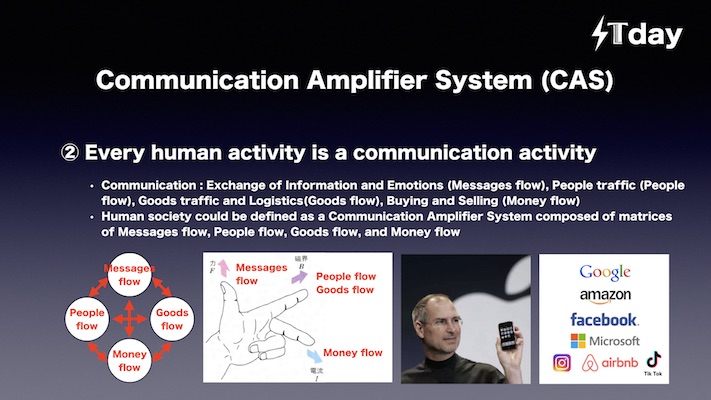
Also, it is a unique feature of CAS theory that every “system” works by “synchronization”. DaVinci focused on “water” and discovered the truth, “flow of changing water = characteristic of life.” CAS theory is “System Thinking” focusing on “communications,” “messages,” and “synchronizations.” The origin of this idea is that when the computer operates, each device (input device, arithmetic device, storage device, display device, output device) exchanges data according to the synchronization signal. In life activity, each cell also has a clock gene, and the body clock in the suprachiasmatic nucleus adjusts the time as the sun rises, and each cell activates in synchronization with it. So, what about human society? All ancient nations are theocracy. And most ancient nations established the time and the measurement and the money. This is the same as setting the time server and communication protocol on the Internet. The NHK program “Human Body” also explains that each organ of the human body communicates using message substances. The brain does not control all organs. Each organ forms a horizontal distributed network system like the Internet. Even in the brain, the dwarf does not control everything. The brain itself is a horizontal distributed network system. In the universe, for example, the celestial bodies such as the Moon and the Earth exchange gravity messages, balance them, and are in sync.
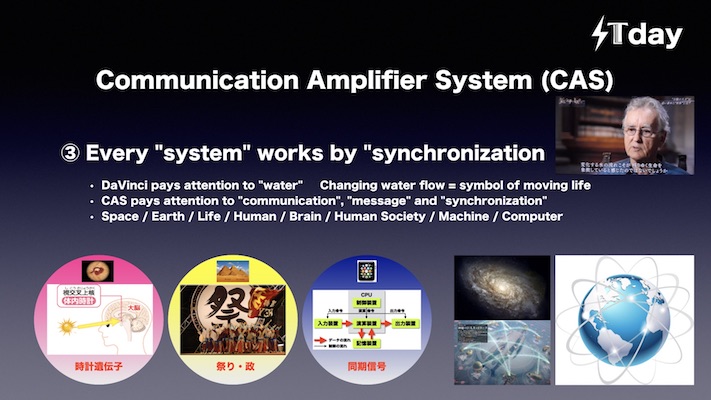
If you look at “synchronization”, you can see a lot of things. We often say “join forces”, but “join forces” means “aligning vector directions all at once”, that is, “synchronizing”. We live in a system that revitalizes the economy by “impressing” and “sympathizing” with the “synchronization” phenomenon. For example, the 2019 Rugby World Cup. The reason Japan did not lose in Scrum is because everyone literally did “joint forces”. In other words, everyone “synchronized” and concentrated the vector direction at one point. That’s what “one team” means. This is true of the scene where Inagaki reached a goal with a splendid ball handling. That ball handling is something that can only be done through enormous practice and close communication. Then, those who saw it are also moved and have a sense of unity. Viewers are also synchronized. Then, everyone will be fine and the economy will be activated. Communication is amplified and there is a huge economic effect.
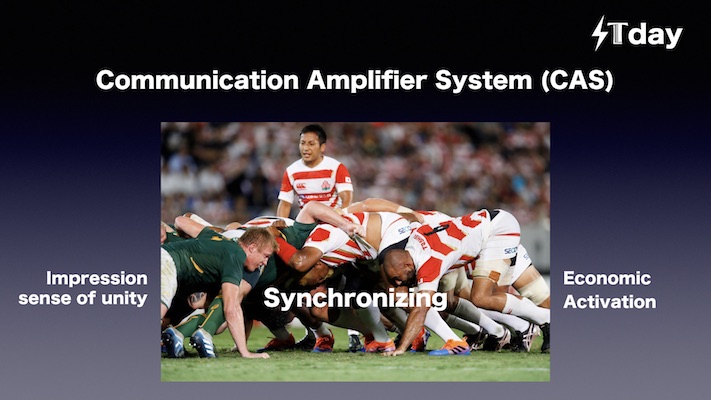
For example, the NHK serial TV novel “Amachan” broadcasted in 2013 cheered up the people of Tohoku who were greatly affected by the Great East Japan Earthquake of 2011. The sympathy with the drama (synchronous) leads to the sympathy of many people in the Tohoku region, and as a result, has a great economic effect of increasing the number of people who go to Tohoku and purchase products from Tohoku. , We are experiencing. This is also a Communication Amplifier System (CAS).
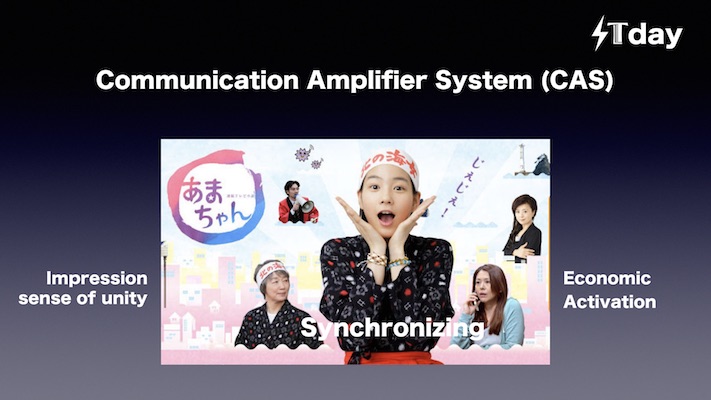
The “festival” is a clear expression of this. For example, why carry Mikoshi(portable shrine) at a festival? You can’t lift Mikoshi unless you scream “Sei-ya, Sei-ya” and synchronize each other. If only one person deviates from this “synchronization”, it is very painful. In other words, everyone carries Mikoshi in a “synchronous” manner both physically and emotionally, and and breaks a good sweat. Then, “excitement” and “oneness” was born, and tried to farm or fight against the enemy together. That was the origin of human society. This phenomenon is accurately expressed by the old Japanese word “Matsurigoto”. “Matsurigoto” meant both “festival” and “politics.” All ancient nations are characterized by the fact that festivals and politics coincide. Why is that? Generally, humans are social animals.
It can be said that humans are monkeys that have evolved in the direction of forming a society as a “communication amplifier system” and trying to achieve something together. Then, based on this CAS theory, it is clear that raising taxes or cutting social security expenses is nonsense simply because of financial difficulties. We can also see that the use of taxes that does not lead to communication amplifiers can result in the decline or destruction of that social system. In addition, it is possible to measure how much policy or management measures have amplified communication or not, and based on that measurement, redesign the social system itself. Demonstrations are taking place around the world now because the current political and economic system is not functioning properly as a “communication amplifier system.” So how do you redesign your political and economic system? It is not enough just to discuss these and other short-term phenomena. We need to evolve our abilities so much that we can solve problems with “System Thinking.”
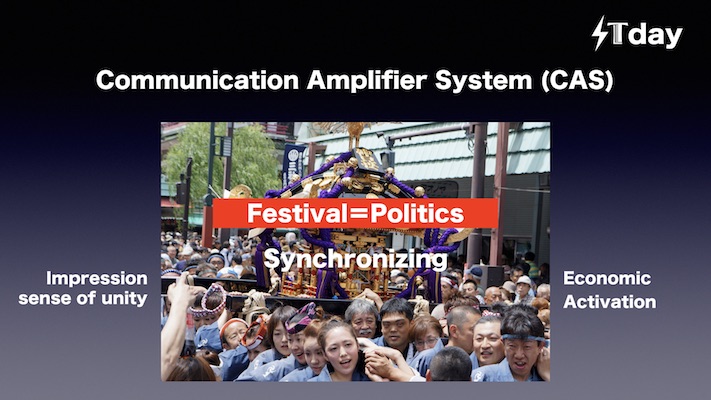
Here is the history of human evolution explained by the “Communication Amplifier System (CAS)” theory. First, life was born on Earth four billion years ago. There is only one mechanism of life on earth. It is born, active and self-replicating, based on a common programming language called DNA. Some life has evolved into multicellular organisms, mammals, and primates. Then, from the primates, the genus Homo was born 6 million years ago. By starting to walk upright, They began to make tools using their hands. And their brain developed rapidly. The humans lived and hunted and gathered in groups of around 30 for 5995,000 years, while raising children in groups. They didn’t do stupid things like we, modern people, leave child care to one mother in a room in an apartment. The children were playing in groups and learning how to live from play. 5000 years ago, the invention of characters and the acquisition of external storage devices enabled humans to invent a system called agriculture and stockbreeding, forming a large group. At that time, an ancient nation was formed by a synchronous system called “festivals and politics coincide.” 500 years ago, the Gutenberg Revolution allowed mass copying of information and destruction of information prices, allowing the general public to share information. And that led to religious reform, the industrial revolution, and the civil revolution, and civil society was realized. On the other hand, the IT revolution that began 50 years ago has realized the personal computer revolution, but has not yet realized the personal Internet revolution. What is equivalent to external storage devices such as “books” and “libraries” that have dramatically evolved human knowledge activities have not yet been realized on the Internet. The Internet is supposed to realize “IT civil society” by mass duplication of information and destruction of information price. However, the current Internet is for GAFA, investors and governments, and the general public remains quite weak. As a result, outdated organizations such as the one-party dictatorship of the Chinese Communist Party may dominate IT and move toward an “IT surveillance society.” In order to overcome this situation and allow the general public to use the power of the Internet for themselves, a major change from the current flyer-type WWW, which can only transmit fragmentary information, to a book-type WWW, which is useful for people’s knowledge activities is essential. The book-type WWW here is not a static “book” like an existing “book”. The book-type WWW here is not a static “book” like an existing “book”, but, Dynamic “books”. That is “Dynabook”, which Alan Kay predicted in a paper “A Personal Computer for Children of All Ages” in 1972.
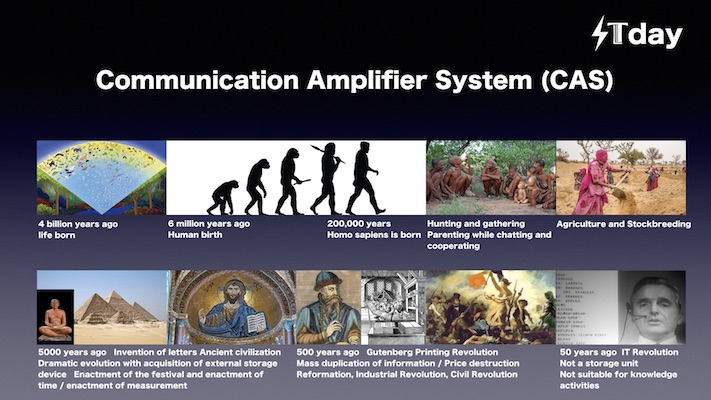
②Reinvent the WWW
So, let’s talk about what “reinventing the WWW” means.

Last year, we asked Alan Kay for a keynote speech at the “IT25.50” symposium. Which was commemorating “the 25th anniversary of the Internet commercialization, and Douglas Engelbart The Demo 50th Anniversary”. He said, “Mosaic, which appeared 25 years after Engelbart’s The Demo, wasn’t a big deal; it was rather terrible. Mosaic People havn’t studied Engelbart, HyperCard, NeXT (they developed WWW on it). They have no interest to study them.” Alan Kay was arguing online with Tim Berners-Lee, the inventor of the World Wide Web. He said “”The web was created by amateurs.” I know HyperCard, NeXT, and GENERAL MAGIC, so I understand what Alan Kay is saying. There was a lineage of “another hypermedia” that was far more advanced than the current WWW, more fun and useful. However, it was the WWW that actually became popular. In this regard, Tim Berners-Lee said, “WWW became popular because it was simple, free, and open.” However, the WWW was barely widespread until Mark Andreessen in 1993 invented Mosaic, a Web browser that could display text and graphics simultaneously. Tim Berners-Lee developed the WWW on NeXT. And, he said “If NeXT was not there, it would have been another few years for me to develop the WWW.” I wonder why he did not develop a browser that displays text and graphics simultaneously, which was standard in NeXT. This year marks the 30th anniversary of Tim Berners-Lee inventing the World Wide Web in 1989. Should we stay on the current WWW forever? I think it’s time to think about a new WWW.
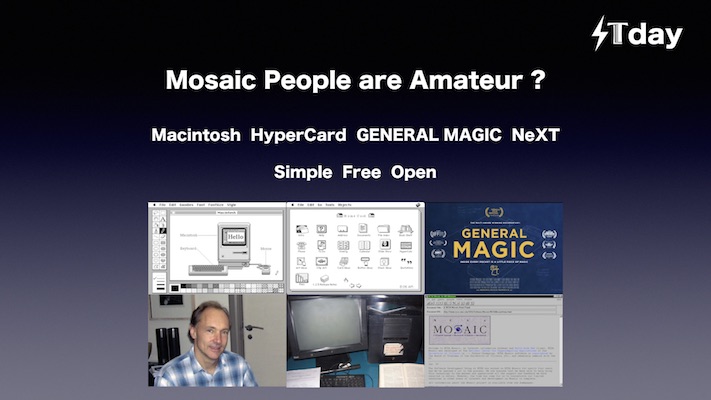
The representative of “Another Hypermedia” is HyperCard announced in 1987. HyperCard is standard on the Macintosh, and anyone without any programming knowledge could easily create their own software (called stackware). And if you have programming knowledge, you could create advanced stackware. I developed and sold a product called “MacSchool” in 1988, which teaches how to use a Mac. It was the world’s first e-learning software and the most commercially successful stackware.
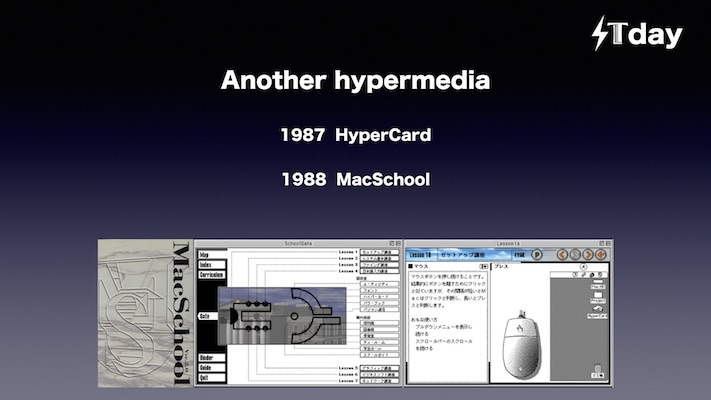
“Another Hypermedia” led to the distribution of expressive hypermedia content based on CD-ROM called “Multimedia”. In 2000, I developed e-learning software for Microsoft Office 2000 (Word 2000, Excel 2000, PowerPoint 2000, Outlook 2000) called “College-Kan Office 2000”. At this time, I developed it with Masashi Kawashima-san. At that time, he was a Waseda University student. Kawashima-san developed MS Office tutorial content on MSN official website based on “College-Kan Office 2000”. He moved to the United States and joined Google, where he was the first Japanese webmaster. Currently, he belongs to Niantic Inc. and is involved in the development of “Ingress”, “Pokemon GO”, “Harry Potter: The Magic Alliance” and more.

The current WWW has a major problem. In short, the current WWW is just a huge collection of files withaddresses and links. In other words, it is a pile of flyers that can handle only fragmentary information, and most of it is garbage. That’s why Google can be profitable. In order to find the information you want to find, you need a technique to enter the right keywords and a technique to narrow down the huge search results. It is very difficult for ordinary users. It is convenient if you only search a short information. Not suitable for people’s knowledge activities. The basic design itself is far from the ideal of the Internet, which Douglas Engelbart predicted, to “augmenting human intellect.”

So what are the basic specifications of the next generation WWW? The next-generation WWW should be a book-type WWW that can handle valuable knowledge. It must be easy to use, exciting, fun and informative for users. And while current WWW browsers are mainly for browsing, to support knowledge activities, “book”, “note” and “conversation” functions must be provided as standard. And the current WWW is for professionals, GAFA, AD Networks, investors, governments, and other strong people. It is not for individuals. Therefore, the next-generation WWW must be designed to release the Internet to individuals just as personal computers have released computers to individuals.
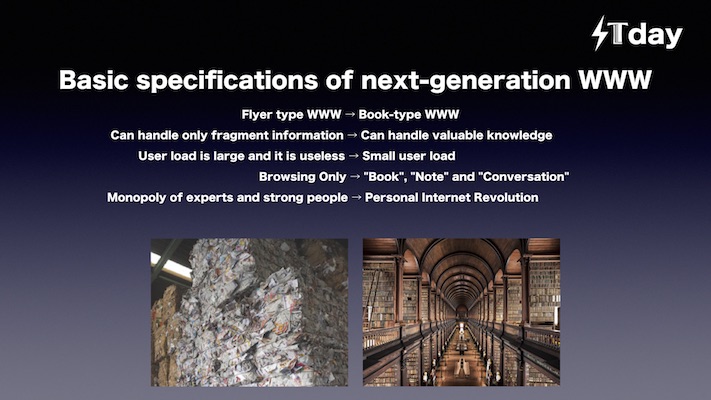
So what is a book-type WWW? The hint lies in the Gutenberg printing revolution, 500 years ago IT revolution. The Gutenberg Bible, printed in 1455, had no cover, no table of contents, no footnotes, no index, and no imprint. At that time, books were very valuable and expensive because they were hand-written and copied one by one by a scribe priest. Only royal nobles and high-priority monks owned books. They let bounder to bound books to fit their own fine library. Therefore, the printer only delivered a bundle of printed papers, like flyers. In this era, before books were arranged today’s style, it is called “incunabula “, and such era has continued for about 50 years.
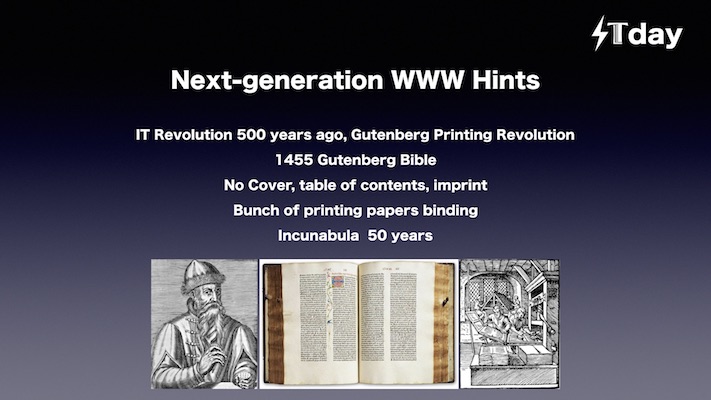
Fifty years after the Gutenberg printing revolution, another celebrity appears around 1500. That person is Aldus Manutius, the “father of commercial printing.” The name Aldus was used for the name of the DTP software called Aldus PageMaker, which opened up the Macintosh DTP market, so it is familiar to anyone who knows the history of DTP. Ardus Manutius invented the prototype of today’s book, including eight-fold books, italics, pagination, and copyright notices. We assume that books have the basic components of a cover (including spine), table of contents, text, footnotes, indexes and imprints. But, for example, the Japanese book had no spine, no table of contents, no footnotes, no index, no imprint. Pagination, which was invented by Ardus Manutius, is to enable random access between the table of contents and the body by assigning successive page numbers to each page of the body and arranging the headings in the table of contents. Why can we select one book from many books on the bookshelf, because the book has a cover and spine. Footnotes are hypertext links. Index is keyword search. The imprint records the book’s identity, such as the book’s title, author name, publisher name, printer name, date of publication, and book code. In other words, the components of a book are all information technologies for realizing random access, and from an information technology point of view, a book is an information unit (object) with high random access. Libraries are considered to be highly random-access knowledge bases (knowledge clouds). Compare the current WWW with the history of books, we are living in the age of incunabula of WWW, which have not yet been formatted, and are distributed like flyers. The next generation WWW useful for knowledge activities like books and libraries, has not yet appeared. It’s about to come.
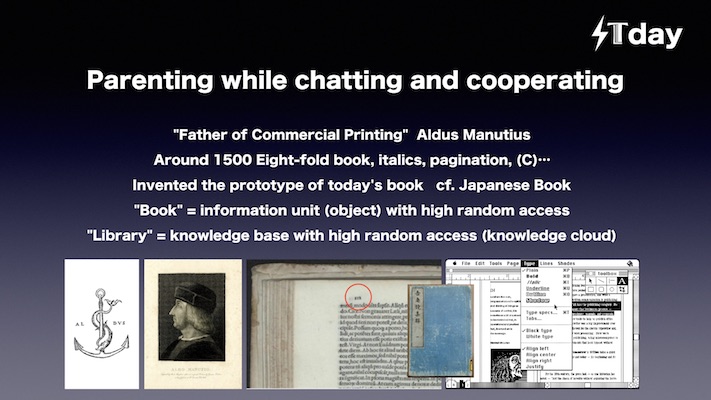
Then, what exactly is a book-type WWW that organizes information systematically and is useful for knowledge activities? In fact, 20 years ago, I developed a client-server system called Kacis (Knowledge Circulation System with AI). Client software Kacis Publisher / Kacis Writer was a document creation software with book components such as cover, table of contents, text, footnote, index, and imprint. For example, you were able to create a huge number of documents in one file, such as “Basic Knowledge of Modern Terms”, “Bible”, “Complete Shakespeare”, “Animal Encyclopedia”, and “Plant Encyclopedia”. Kacis Publisher could set copyright-protection and could publish immediately or exported as an XML file. Word processors cannot do this. This is because word processors basically have a “scroll” structure. The drawback of “scrolls” is that for large documents, you have to go back and forth in order to reach any information, and poor random access. In the window on the outline processor side, an overall configuration plan, that is, a “table of contents” is created, and in the window on the word processor side, cards corresponding to the “text” corresponding to the “table of contents” are continuously arranged. Clicking on any “table of contents” immediately led to the corresponding “Body”. You were able to organize a huge amount of information into a single book. It was a document processor suitable for creating “structured documents” such as academic papers, and a knowledge processor that greatly improved the efficiency of knowledge activities. Kacis Cabinet, a server software, is a metaphor of the “library” that allows documents created with Kacis Publisher / Kacis Writer to be efficiently stored and randomly accessed. Kacis Publisher / Kacis Writer was awarded “Software Product of the Year 2001” (SOFTIC). In the United States, Kacis was acclaimed by IDG’s DEMO Letter for DEMO members. DEMO was the gateway to ventures at that time. In this way, Kacis was expected to have a future. Unfortunately, however, the circumstances of the parent company of the partner development company (trading company recession) caused the development to be stopped.
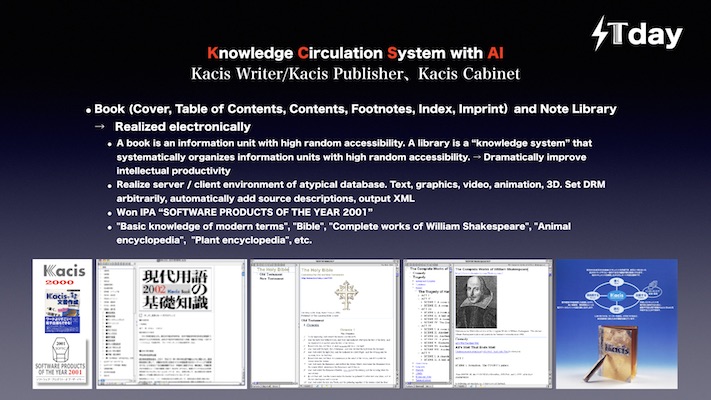
Kacis has been discontinued. However, Confluence, a structured document creation software and collaboration tool very similar to Kacis, is now the global standard for corporate wikis. According to Wikipedia, Confluence’s clients include Adobe, Sun Micro, IBM, John Hopkins University and the United Nations. And according to the official website, there are currently 35,000 clients worldwide.
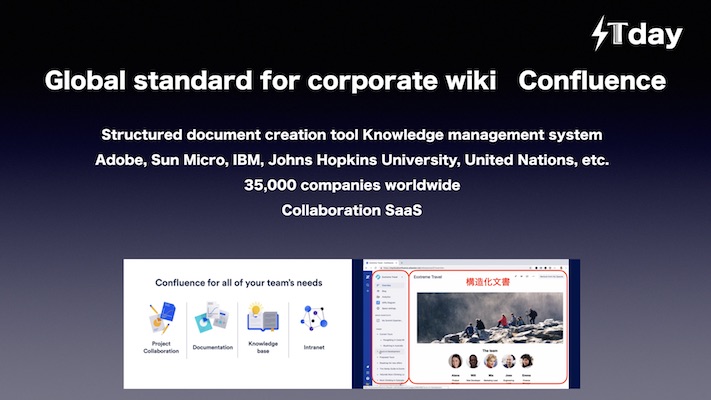
The advantage of structured documents like Kacis and Confluence over scroll like word processors is that they are much more random accessible. As evidenced by Adobe’s adoption of Confluence for internal wikis, structured documents are better at managing corporate documents than PDF, as well as word processor. And, comparing the current page of the WWW’s “Complete Shakespeare” and the page of Wikipedia’s “Shakespeare” with Kacis’s “Complete Shakespeare”, you can see how structured documents are superior. Basically, on a web page or Wikipedia with a scroll structure, it takes a lot of time and effort to switch back and forth between the table of contents and the text. And you don’t even know where you are currently reading in the whole document. In the case of Kacis, on the other hand, the table of contents is always displayed independently of the text, so you can access randomly. And you can read through the document in a way that always tells you where you are reading in the whole document. Furthermore, in the case of Kacis, texts, graphics, movies, and 3D graphics can be quoted from books to notes to the extent permitted by the copyright protection set by the author. In addition, the source was automatically specified.
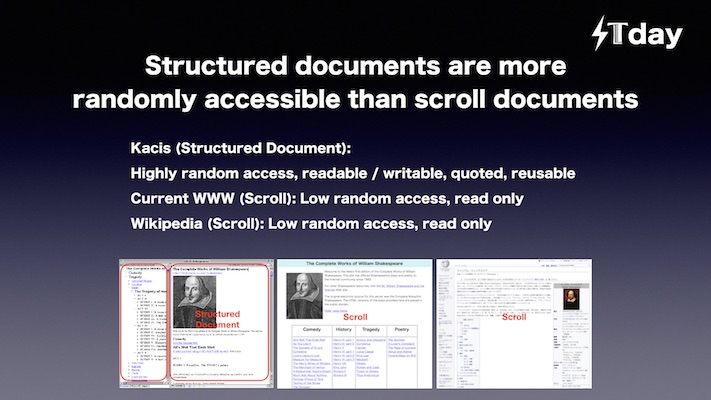
So, how do we specifically develop the next generation WWW? When it comes to overall redesign, it takes a lot of time and effort. So I think it’s better to start where you can. One method is to gradually add the functions of book-type WWW to the browser. For example, I created a prototype to add a structured document. Firefox and Safari display bookmarks on the left side of the main window, so I was able to use these bookmarks to create a pseudo-“table of contents”. In the case of Google Chrome, prototypes could not be created because bookmarks are displayed in a separate window. This prototype is pseudo. Actually, I think it is realistic to work with each browser developer to develop a “table of contents” window, and to develop standard web page specifications corresponding to this “table of contents”. If the book-type WWW coexists in the flyer-type WWW in this way, the number of sites that support the book-side WWW will gradually increase. For example, long news and textbooks are much more convenient to use on a book-type WWW. Another possible approach is to work with e-book application developers such as Kindle to develop a plug-in for browsers and to have the note function significantly expanded. It is more unnatural to have a web browser and an e-book separately. Eventually, both will dock. Readers will be able to create their own notebooks, wandering around the Web, clipping relevant information, and taking notes on the main points of e-books. That is exactly the knowledge activity. Only then will WWW help improve human intelligence.
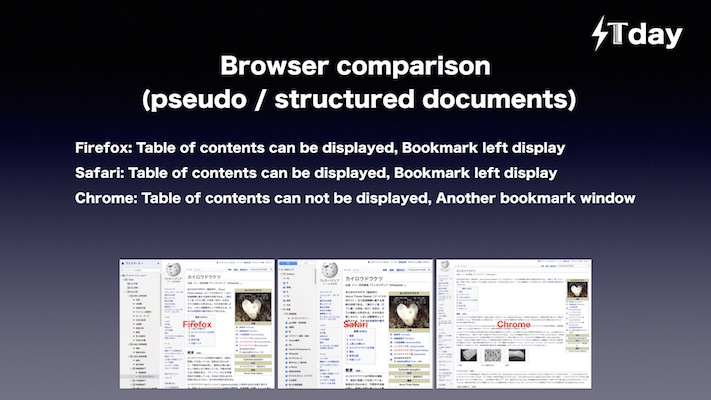
③The Personal Internet Revolution
Finally, I would like to talk about the “Personal Internet Revolution”.
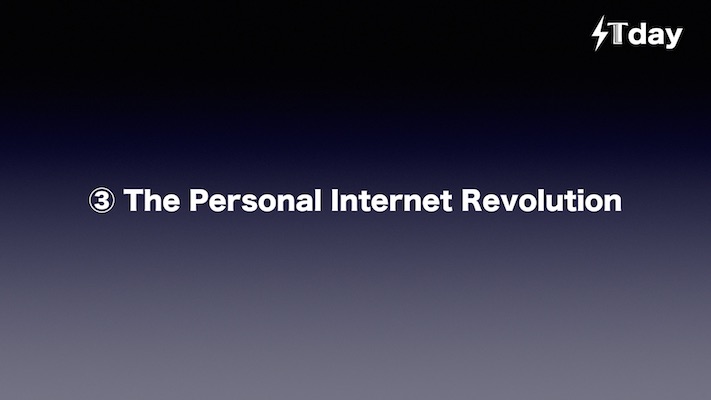
In 1984, the Macintosh appeared along with the CM “1984”. The CM declared that “1984 won’t be as the novel 1984 expected.” “People won’t be dominated by Big Brother because the Macintosh is coming.” In this way, The CM declared the “Personal Computer Revolution”. And as a result, everyone can now have a personal computer called a smartphone. However, the world of the Internet connected by the smartphone is not yet personal at all. When Engelbart performed The Demo, computers meant either large computers that occupied the entire room, or mini computers that were as large as big refrigerators. They were very expensive and difficult to operate, and were for nations, large corporations, and professionals. At that time, how many people could imagine, such as the time when individuals could use computers someday? Today, the Internet, especially WWW, is for GAFA, investors, and nations. How many people could imagine, such as the time when individuals could use The Internet, WWW as their will someday? But, as you can imagine from the past history, if people who are eager to realize the personal Internet revolution come together and try to do it seriously, it is not impossible. Therefore, in 2019, “ITday Japan 2019” will declare the “Personal Internet Revolution” here.
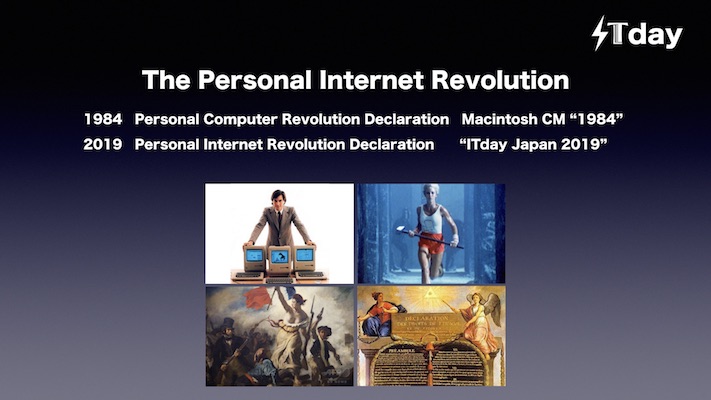
Finally, I would like to talk about the “Law of IT development history” that I discovered. In the case of “text / image”, “video”, “computer”, and “web”, all of them start with “fragments” first, then “scrolls”, and evolve into “randomly accessible” ones. There is a law like this. In the case of “characters / images”, first recorded in “fragments” such as clay tablets (cuneiform characters) and turtle shells / animal bones (carapace characters), and then recorded in “scrolls” such as papyrus, wooden and bamboo scroll. And then recorded in random accessible “books”. In the case of “video”, first, “fragments” that are viewed like a flip book like Kinora, then “scrolls” such as films and videotapes, and evolved into “random access media” such as DVDs and Blu-ray Disks. In the case of “computers”, first, “fragments” such as punch cards, then “scrolls” such as paper tape and magnetic tape, and evolved into “random access media” such as CD-ROMs and DVD-ROMs. In the case of “WWW”, first, “fragments” such as files, and then “scrolls” such as timeline of Twitter and Facebook. Kacis, a “random access media,” should appear after “scrolls” such as Twitter and Facebook. As inferred from this “law of the history of IT development,” the next-generation WWW will definitely have high “random access” and “multimedia.” For example, outdated content that cannot be viewed anytime, anywhere, such as a TV program, will be viewed anytime, anywhere, and random access for each scene will be dramatically increased. And separate IT will be concentrated in the cloud. The main battlefield for IT development will be how to store data in the cloud in a highly random-access form and how to maximize the performance of each client device.
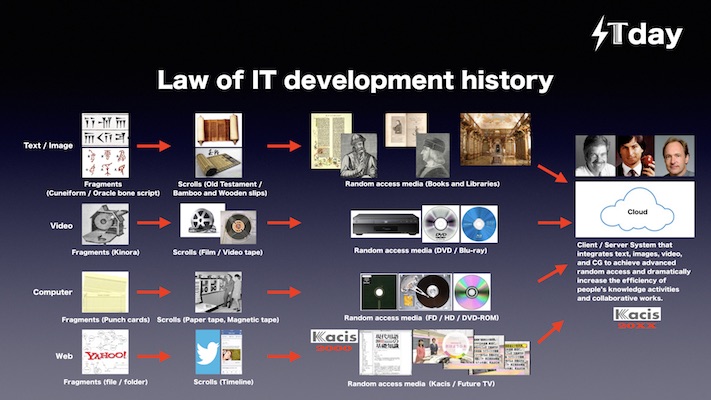
Summary
Here is the summary.
In “ITday Japan 2019”, I would like to make three proposals to solve the serious problem that “To be IT surveillance society, or to be IT civil society, that is the question”.
The first is “System Thinking.”
Analyzing human society with “system thinking” such as “Communication Amplifier System (CAS)” and solving problems.
The second is “reinvent the WWW.”
A major change from a flyer-type WWW that can handle only fragment information to a book-type WWW that is useful for knowledge activities.
The third is the “Personal Internet Revolution”.
The Macintosh, the world’s first commercial personal computer, appeared with the message, “The Computer for the Rest of US,” and completed the “Personal Computer Revolution.”
“ITday Japan 2019”, together with the message “The Internet for the Rest of Us”, declares that it aims to realize the “Personal Internet Revolution” and will work on concrete development.
If you can agree with us, please join us.
Thank you very much.
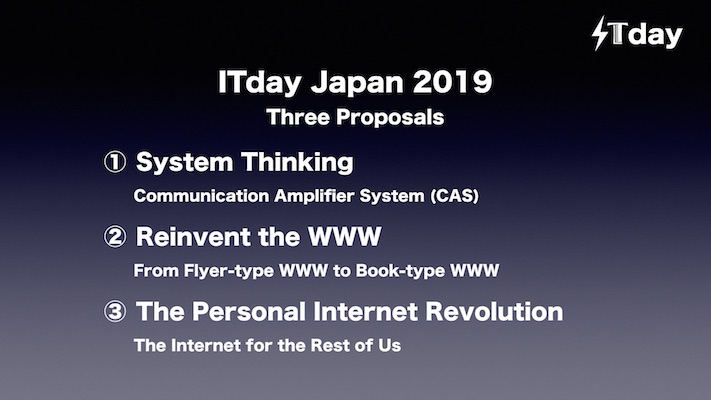
Next, under the moderation of journalist Katsura Hattori, 6 persons panel discussion was held.
Participants were AI engineer Tomonari Sonoda, Toshihiro Takagi, Representative of the Executive Committee of “ITday Japan”, Nozomi Takahashi of Osaka Midorikai (Zoom), Eiji Aoki of Oita Hyper Network Society Research Institute(Zoom), Technology writer Kazutoshi Otani of Tokyo Kanda MOSA(Zoom).
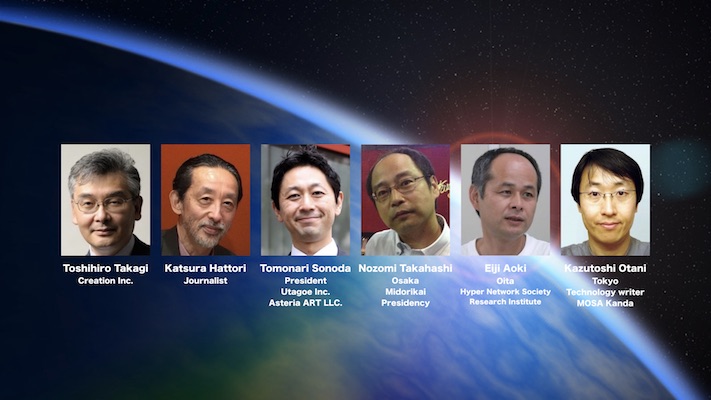
【Postscript】
We are now at a crossroads between “IT surveillance society” vs. “IT civil society”. Chinese government and Chinese high-tech companies are now concetrating in building IT surveillance society. For example, they are building 400 million surveillance AI cameras network across China to complete a street surveillance system that will instantly identify criminals by 2020. And China’s largest Alipay / Sesame Credit makes credit scores not only for financial transactions, but also for educational backgrounds, family, assets, personality, preferences, personal connections, comments, and actions. Provide incentives for those who are desirable for the government. On the other hand, provide disincentives for government-undesirable persons, who will soon be unable to board high-speed rail and aircraft, and will be able to quickly forfeit, arrest and confine property. And the negative history of the Communist Party of China’s one-party dictatorship, such as the Tiananmen case, will be erased. Critics such as human rights lawyers and Muslims are thoroughly suppressing and brainwashing. The Chinese government has not broken its hard-line stance against protests by Hong Kong citizens over the “2019 Hong Kong extradition bill,” and there is no clue to the solution. The U.S.-China 5G war broke out and the U.S. decided to eliminate Huawei because it realized that China could seize infrastructure around the world. “IT civil society” has no way to be realized except by creating the citizens themselves, without leaving it to the government and platformers.
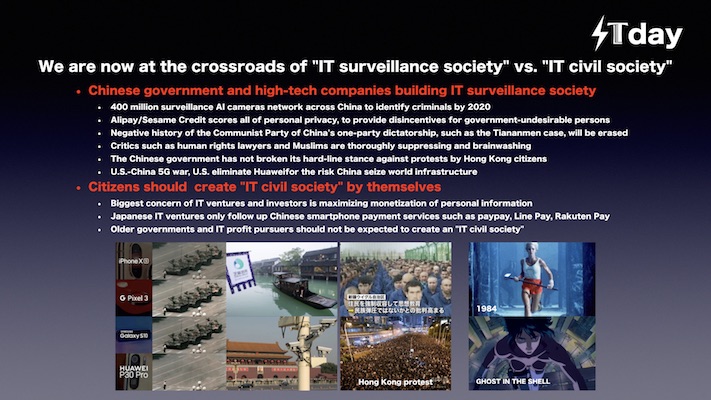
The IT revolution basically promotes the transition from a pyramid society to a horizontally distributed network society. In the transition period, the Pyramid organization is wobbling, while the Internet growth is immature. For this reason, it is difficult to predict whether to head for an IT surveillance society or an IT civil society.
And “IT civil society” is not something that is left to governments and platformers. There is no way to achieve this, except for the citizens themselves to be active and create themselves.
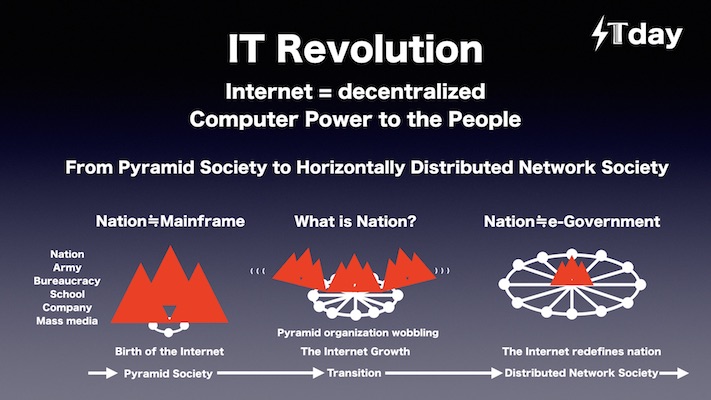
The ITday Executive Committee will enact December 9 as “ITday” to commemorate the December 9, 1968, when Douglas Engelbart The Demo was held. And on December 9, we will hold the “ITday” symposium worldwide every year,.
We will continue to work toward realizing an “IT civil society” for the people by the people of the people. If you can agree with the purpose of ITday, please come and join us.
For inquiries, please contact here (http://itday.net/ask/).
“ITday” Executive Committee / Secretariat Creation Inc. Toshihiro Takagi Facebook ID: Toshihiro Takagi


